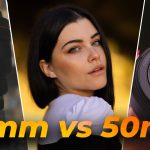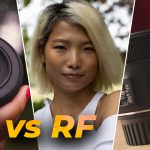Hi guys. Today we’re going to have a look at the new version of the lens we talked about last week, and that is the Canon RF 50mm f1.8 STM.
We’re going to look into what it’s good for, who should buy it, who shouldn’t, and whether you should grab this new RF version of the lens, or stick with your older EF version, and slap an adaptor on.

Aperture & Focal Length
First, let’s talk about the aperture and focal length. As you can tell from the name, this lens has a fixed focal length of 50mm, and the aperture opens as wide as f/1.8.
The benefits of a fixed focal length is that it tens to produce sharper images. On the other hand, the perk of being able to open the aperture as wide as f/1.8 is that that allows in more light, thus allowing you to shoot in low-light conditions.
This will come in handy when you’re doing that portrait photoshoot during golden hour, and you’re starting to run out of natural light. If you were using an 18-55mm kit lens, or the Canon EF 75-300mm lens, you’d be forced to either end the session, or bump up your ISO, thus getting noisier photos.
With the Canon RF 50mm f1.8 STM, you’ll be able to keep shooting for a while longer. Also, thanks to the 7-blade circular aperture, you’ll get beautiful smooth Bokeh.
As a quick side note, I’ve reviewed both the 18-55mm kit lens, and the 75-300mm lens on my YouTube channel.
And now, before moving on to this lens’s size and build, it’s also important to mention its minimum focusing distance, which is 0.98 feet, or 11.76 inches. This is important to know, as every lens has a minimum focusing distance.
In practice, what it means is that when you’re trying to photograph your subject, if you’re too close, the lens will struggle to focus properly. It needs a minimum distance between it, and the subject, in order to be able to focus properly.

Size & Build
So now, we can jump to the size & build section. As you might be able to tell from the footage, this lens is quite compact.
In fact, much like its older EF sibling, it looks like a toy on my Canon R5. The fact that it’s also quite lightweight, weight in at only 5.6 oz, or 159g, this only adds to the toy-like feeling of this lens.
In terms of physical size, the lens measures 1.61 x 2.72 x 2.72 in. The build quality overall is good though, especially when you examine the metal lens mount.

Image Quality
Now, let’s address why this lens, and its older sibling, are referred to as the ‘nifty fifty’. Simply put, 50mm is considered to be a great focal length for a wide range of applications.
Portraits
You can shoot portraits with it, you can do product photography if you want, you can capture animals in the wild, if they’re not too far away, and you can even use it for street photography.
In fact, one of its advantages for street photography is the fact that this lens is so small. Due to its diminutive size, people will be less intimidated when they see it, as opposed to a larger lens. Also, the fact that its focal length is 50mm allows you to capture your subject from somewhat further away, so you don’t have to get uncomfortably close.
Low Light
We’ve mentioned some of its other perks earlier, like the fact that you can shoot in low light, but it also has one major perk for shooting video, assuming that you’re using a camera like the Canon R5 for example, which has in-body image stabilisation.
Image Stabilisation
Through the use of the RF system, the camera can communicate with the camera body, and thus you can achieve up to 7 stops of shake correction.
This is pretty sweet, as you wouldn’t expect a lens like this to actually have image stabilisation capabilities. You need to make sure that you have in-body stabilisation enabled in the camera menu though.
By the way, I’ve reviewed both the Canon R, and the R5 on my YouTube channel.

Also, if you’re interested in purchasing any of the items mentioned in this article, I have affiliate links down below, and also some very useful links to different types of tools that I use to make videos.
Now, in addition to the stabilisation, the STM feature of the lens helps provide smooth and quiet autofocus during video recording, as well as when taking photos. This is especially useful when shooting video, as it makes it less likely that unwanted mechanical lens noises will pollute your audio track.
And now that we’ve covered all the great things that this lens can do, I’m going to show you some photos and videos that I’ve taken with it, on the Canon R5.

Control
In terms of control, the lens has the usual AF/MF button on the side, and a nice control ring which allows you to manually control focus.
Longevity
Like most lenses, when it comes to its longevity, I’d recommend being careful with it, especially as it has no weather sealing. I’d look at potentially getting a filter for it, like I have on my Canon RF 15-35mm f2.8 L IS USM lens.
Conclusion
And now, the conclusion. Should you buy the Canon RF 50mm f1.8 STM?
As we’ve established earlier, this lens takes beautiful photos and videos, and its incredible versatility means that every photographer and videographer should probably have one in their bag.
But, since that is the case, there is a chance you might already have the EF version of this lens, in which case you’ll be wondering whether it’s worth purchasing this new one.
If you have a lot of EF glass already, I’d recommend you probably just get the adaptor. You’ll spend a little bit of money, but you’ll be able to use your old lenses, and you don’t have to buy any new RF glass, strictly speaking.

This is especially the case if you mostly just want to take photos. Alternatively, if you wish to shoot some video as well, I’d recommend getting the RF version, specifically because of the image stabilisation offered in conjunction with the Canon R5.
If you’d like to purchase any of the items I’ve mentioned in this article, or see how much they cost in your country, I have a link down below where you can view them.
Thank you for reading my review of the Canon RF 50mm f1.8 STM. I invite you to have a look at some of my other articles. We have something for everyone, whether you’re interested in audio, or cameras and lenses. Alternatively, if you prefer video reviews, feel free to have a look at my YouTube channel.
Product Links
Down below you will find all of the items I talked about in this article.



